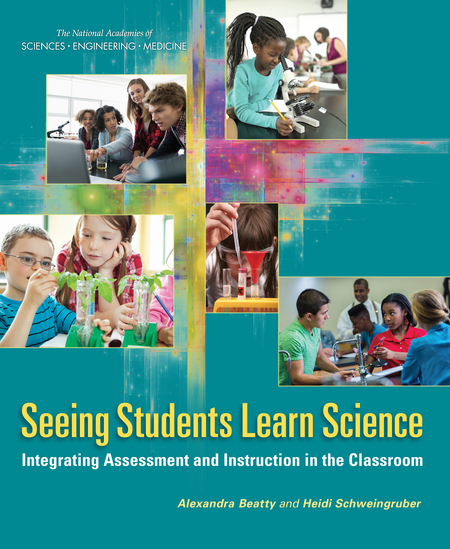New NAP Publication Helps Teachers Assess 3-Dimensional Learning in the Classroom
By Cindy Workosky
Posted on 2017-03-28

Seeing Students Learn Science
It is a truly exciting time in science education. Science educators across the country are adapting to a new vision of how students learn science guided by the Framework for K–12 Science Education. As a result, science instruction is changing to better tap into students’ natural curiosity and deepen their understanding of the world around them. As instruction is changing, assessments need to change as well. Many science educators recognize that traditional assessments are not appropriate for capturing three-dimensional science learning. But, they may not know what assessments of three-dimensional learning should look like nor how they can be used effectively in science classrooms.
On March 30 at the NSTA National Conference in Los Angeles, I will introduce science educators to a new book from the Board on Science Education at the National Academies of Sciences, Engineering, and Medicine, Seeing Students Learn Science: Integrating Assessment and Instruction in the Classroom. The book draws on research-based recommendations for assessment to explore how classroom teachers can use assessments as part of instruction to advance students’ three-dimensional learning.
Traditional science assessments do not allow teachers to fully understand students’ mastery of science and engineering practices, nor do they provide insight into students’ learning trajectories. In contrast, effective classroom assessments in science can help teachers collect information about students’ understanding of core ideas and crosscutting concepts as well as students’ ability to engage in the scientific and engineering practices. Good assessments of 3–D science learning can help teachers make decisions about next steps for learning and identify the supports that individual students or groups of students may need. They can also help students take control of their own learning by helping them see what they have mastered and where they may need more practice. A major goal is for assessment to become an integral part of science teaching practice, rather than an interruption.
The book is organized around key questions related to classroom assessment.
- What’s really different? — Describes how ideas about science learning and instruction have changed and why different kinds of assessments are needed
- What does this kind of assessment look like? — Discusses specific examples to see how classroom assessment of 3-dimensional learning can work in practice.
- What can I learn from my students’ work? — Provides a look at the sorts of information that can be obtained from different types of assessment and how they can provide windows into students’ thinking.
- How can I build new kinds of assessments into the flow of my instruction? — Suggests ways to adapt assessments teachers already use so that they are consistent with three-dimensional learning and instruction.
- How can I work with others in my school, district, and state? — Discusses how classroom assessment related to broader assessment systems that include large-scale assessments used for monitoring purposes.
The new book is designed to help teachers create and implement classroom assessments that capture three-dimensional learning. It helps teachers think about how to embed assessments within engaging classroom tasks and how to interpret and use novel kinds of assessment information. It also offers ideas and questions teachers can use to reflect on what they can adapt right away and what they may need to work on developing over time. My talk will highlight some of the key ideas from the book, illustrated with examples, and explore how the book can be used to help teachers’ reflect on and improve their classroom instruction. I would love to see you there! If you will not be at the conference, read the book online here.
_____________________________________________________
Editor’s Note: Featured speaker session will take place on Thursday, March 30 from 12:30-1:30 pm at the Los Angeles Convention Center, Petree Hall C.

Heidi Schweingruber
Heidi Schweingruber is the director of the Board on Science Education at the National Research Council (NRC). She co-directed the study that resulted in the report A Framework for K-12 Science Education (2011). She served as study director for a review of NASA’s pre-college education programs completed in 2008 and co-directed the study that produced the 2007 report Taking Science to School: Learning and Teaching Science in Grades K-8. Prior to joining the NRC, Heidi worked as a senior research associate at the Institute of Education Sciences in the U.S. Department of Education. Heidi holds a Ph.D. in psychology and anthropology, and a certificate in culture and cognition from the University of Michigan.
The mission of NSTA is to promote excellence and innovation in science teaching and learning for all.
Future NSTA Conferences
2017 National Conference
STEM Forum & Expo
Follow NSTA
Disclaimer: The views expressed in this blog post are those of the author(s) and do not necessarily reflect the official position of the National Science Teaching Association (NSTA).


